Enhance Your Wellbeing In Nature
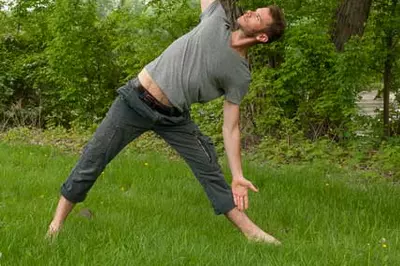
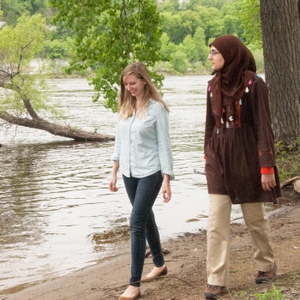 Nature reduces our anger, fear, and depression and increases our positive mood and psychological wellbeing. This not only increases our happiness, it makes us feel better physically.
Nature reduces our anger, fear, and depression and increases our positive mood and psychological wellbeing. This not only increases our happiness, it makes us feel better physically.
Time in nature also brings us out of ourselves and our narrow concerns and connects us to a larger world where we find beauty and interest. Thus the environment is connected not only to our physical, emotional, and spiritual health, but to purpose and community.
Get outside
So it is clear that it is important to get outside! If you can get to the country, or a lake, that’s wonderful. But even if you live in an urban area, spend time in your yard or find a park or a greenspace with trees and bushes. Go outside on your lunch hour if you can to get a “breath of fresh air” and give your mind a break. You should find more energy for your afternoon mental tasks.
“Green” your exercise
We all know the long list of physical, mental, and emotional benefits of exercise. Exercise improves attention in the young and cognitive functioning in the old. It reduces stress and acts as an antidepressant. And of course, exercise is key if we would to avoid gaining weight, especially as we grow older. But much as we know all these benefits, we can’t always motivate ourselves to exercise regularly.
 This is where nature can help. An appealing place to walk or bike can get us off our seats and moving. And once we start, the beauty of natural surroundings keeps us motivated to continue. Studies show that exercising outdoors decreases perceptions of fatigue.
This is where nature can help. An appealing place to walk or bike can get us off our seats and moving. And once we start, the beauty of natural surroundings keeps us motivated to continue. Studies show that exercising outdoors decreases perceptions of fatigue.
Moreover, exercising outdoors reduces stress and enhances mood even more than exercise indoors. In a study published in Mind, one group of participants walked in an area with woods, grasslands, and lakes, and the other in a shopping mall. The outdoors group had less depression, anger, tension, and overall better mood than the indoor group. A series of studies in Japan showed that walking in forests, as opposed to urban environments, lowered blood pressure and stress hormones well beyond the time of the walk.
So find somewhere with trees, bushes, wild grasses or flowers, water, and other such natural elements and go for a walk or run or bike. Gardening is another wonderful way to be active outside.
Watch your screen time
According to the Bureau of Labor in June 2012, the average American spends 2.8 hours a day watching television, and that is probably a conservative estimate. In addition, some age groups spend significant amounts of time playing games or using computers for leisure. In all, it means that a lot of our leisure time is spent sitting indoors in front of a screen.
And the risks associated with screen time are not insignificant, including insomnia, depression, and isolation, and increased mortality.
So consider how much time you spend each time in front of a screen (TV or computer). Could you reduce that time to go outside? You can get even more benefit if you do so with a friend!
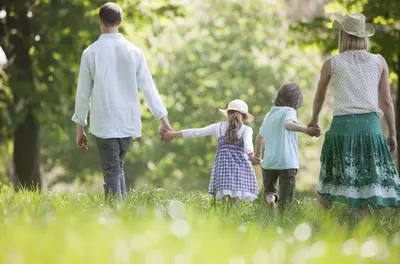
Incorporate nature into family activities
Lack of nature contributes to children's health problems.
Richard Louv’s Last Child in the Woods focuses on the problems children face when they spend too much time inside with television, video games, and smart phones. Louv suggests that this lack of nature and exercise has contributed to the rise in children’s health problems, including obesity and hypertension.
He urges parents to incorporate nature into their family activities and encourage their children to explore the outdoors.
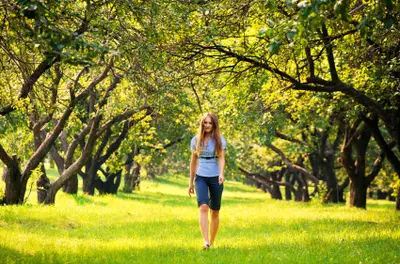
Increase wellbeing with a leisurely walk
Walking has numerous health benefits and even more so if you walk outside.
Increase Wellbeing with a Leisurely Walk
Walking has numerous health benefits. In fact, walking just 30 minutes a day can significantly reduce your risk for major chronic diseases. There are even more benefits if you walk outside, preferably in a green space, such as a park or hiking trail.
Before you go out into nature, assign and write down a number on a scale of 1 (poor) to 10 (excellent) that describes your physical, mental, and spiritual health. (You should have 3 numbers.)
Then go for a leisurely walk in nature, stopping as you wish to enjoy the scenery or rest. Practice deep breathing as you walk, or sit down if you prefer. Let your thoughts come and go, without worrying or fantasizing about anything. Simply notice nature around you--the breeze on your face, the smell of recent rain, or the sound of birds chirping.
When you return home, immediately evaluate yourself using the same scale you used when you left. Now compare your numbers. Has anything changed as a result of your walk?
Learn more
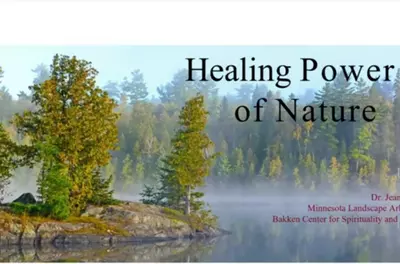
Free webinar
Dr. Jeannie Larson, faculty at the Bakken Center for Spirituality & Healing and an expert on nature-based therapies, talks about the healing power of nature.
Berman, M. G., Jonides, J., & Kaplan, S. (2008). The cognitive benefits of interacting with nature. Psychological Science, 19(12), 1207-1212.
Bowler, D. E., Buyung-Ali, L. M., Knight, T. M., & Pullin, A. S. (2010). A systematic review of evidence for the added benefits to health of exposure to natural environments. BMC Public Health, 10, 456.
Bureau of Labor. American Time Use Survey Summary. June 22, 2012. Accepted at http://www.bls.gov/news.release/atus.nr0.htm on May 11, 2013.
Hartig, T. (1991). Restorative effects of natural environment experiences. Environment and Behavior, 23, 3.
Marcus, C., & Barnes, M. (Eds.) (1999). Healing gardens ( Trans.). New York, NY: John Wiley and Sons.
Mayer, F. S., Frantz, C. M., Bruehlman-Senecal, E., & Dolliver, K. (2009). Why is nature beneficial? Environment and Behavior, 41(5), 607-643.
Mind Organization. (2007). Ecotherapy: The green agenda for mental health. UK: Mind Publications.
Morrison, C., & Gore, H. (2010). Relationship between excessive internet use and depression: A questionnaire-based study of 1,319 young people and adults. Psychopathology, 43(2), 121-126.
Park, B., Tsunetsugu, Y., Ishii, H., & et al. (2008). Physiological effects of shinrin-yoku (taking in the atmosphere of the forest) in a mixed forest in shinano town, japan. Scandinavian Journal of Forest Research., 23(3), 278.
Stamatakis, E. (2011). Screen-based entertainment time, all-cause mortality, and cardiovascular events: Population-based study with ongoing mortality and hospital events follow-up. Journal of the American College of Cardiology, 57(3), 292-299.
Selub, E., Logan, A. (2012). Your brain on nature. Mississauga, Ontario: Wiley.
Taylor, A., Kuo, F. (2008). Children with attention deficits concentrate better after walk in the park. Journal of Attention Disorders; 12 (5), 402.
Ulrich, R. S., Simons, R. F., Losito, B. D., Fiorito, E., Miles, M. A., & Zelson, M. (1991). Stress recovery during exposure to natural and urban environments. Journal of Environmental Psychology, 11(3), 201-230.
van der Berg, A. (2010). Green space as a buffer between stressful life events and health. Social Science & Medicine, 70(8), 1203-1210.
Weinstein, N. (2009). Can nature make us more caring? Effects of immersion in nature on intrinsic aspirations and generosity. Personality and Social Psychology Bulletin, 35, 1315.




